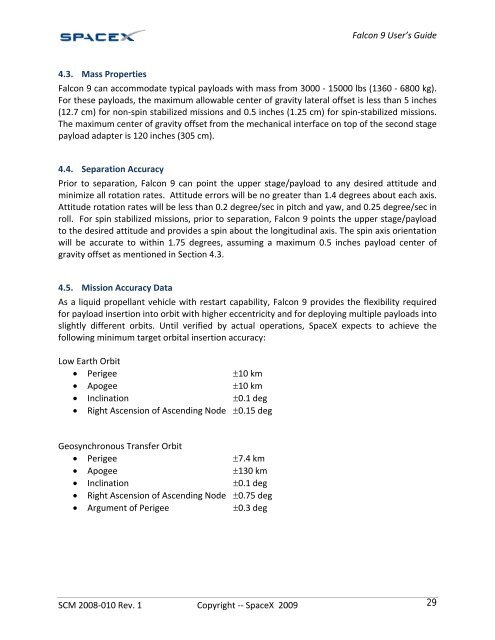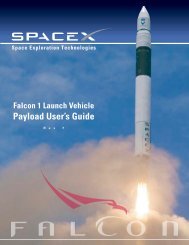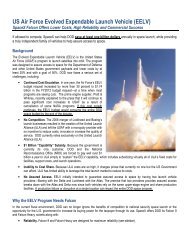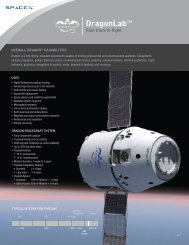Falcon 9 Launch Vehicle Payload User's Guide - SpaceX
Falcon 9 Launch Vehicle Payload User's Guide - SpaceX
Falcon 9 Launch Vehicle Payload User's Guide - SpaceX
You also want an ePaper? Increase the reach of your titles
YUMPU automatically turns print PDFs into web optimized ePapers that Google loves.
<strong>Falcon</strong> 9 User’s <strong>Guide</strong><br />
4.3. Mass Properties<br />
<strong>Falcon</strong> 9 can accommodate typical payloads with mass from 3000 ‐ 15000 lbs (1360 ‐ 6800 kg).<br />
For these payloads, the maximum allowable center of gravity lateral offset is less than 5 inches<br />
(12.7 cm) for non‐spin stabilized missions and 0.5 inches (1.25 cm) for spin‐stabilized missions.<br />
The maximum center of gravity offset from the mechanical interface on top of the second stage<br />
payload adapter is 120 inches (305 cm).<br />
4.4. Separation Accuracy<br />
Prior to separation, <strong>Falcon</strong> 9 can point the upper stage/payload to any desired attitude and<br />
minimize all rotation rates. Attitude errors will be no greater than 1.4 degrees about each axis.<br />
Attitude rotation rates will be less than 0.2 degree/sec in pitch and yaw, and 0.25 degree/sec in<br />
roll. For spin stabilized missions, prior to separation, <strong>Falcon</strong> 9 points the upper stage/payload<br />
to the desired attitude and provides a spin about the longitudinal axis. The spin axis orientation<br />
will be accurate to within 1.75 degrees, assuming a maximum 0.5 inches payload center of<br />
gravity offset as mentioned in Section 4.3.<br />
4.5. Mission Accuracy Data<br />
As a liquid propellant vehicle with restart capability, <strong>Falcon</strong> 9 provides the flexibility required<br />
for payload insertion into orbit with higher eccentricity and for deploying multiple payloads into<br />
slightly different orbits. Until verified by actual operations, <strong>SpaceX</strong> expects to achieve the<br />
following minimum target orbital insertion accuracy:<br />
Low Earth Orbit<br />
• Perigee ±10 km<br />
• Apogee ±10 km<br />
• Inclination ±0.1 deg<br />
• Right Ascension of Ascending Node ±0.15 deg<br />
Geosynchronous Transfer Orbit<br />
• Perigee ±7.4 km<br />
• Apogee ±130 km<br />
• Inclination ±0.1 deg<br />
• Right Ascension of Ascending Node ±0.75 deg<br />
• Argument of Perigee ±0.3 deg<br />
SCM 2008‐010 Rev. 1 Copyright ‐‐ <strong>SpaceX</strong> 2009 29





